ARCHIVED - Fisheries and Oceans Canada
 This page has been archived.
This page has been archived.
Archived Content
Information identified as archived on the Web is for reference, research or recordkeeping purposes. It has not been altered or updated after the date of archiving. Web pages that are archived on the Web are not subject to the Government of Canada Web Standards. As per the Communications Policy of the Government of Canada, you can request alternate formats on the "Contact Us" page.
2009-10
Report on Plans and Priorities
Fisheries and Oceans Canada
The original version was signed by
The Honourable Gail Shea, P.C., M.P.
Minister of Fisheries and Oceans
Table of Contents
Minister's Message
Section I: Departmental Overview
- DFO at a Glance
- Strategic Context
- Planning Summary and Departmental Priorities
- Key Corporate Risks
- Expenditure Profile
Section II: Analysis of Program Activities by Strategic Outcome(s)
- Safe and Accessible Waterways
- Sustainable Fisheries and Aquaculture
- Healthy and Productive Aquatic Ecosystems
- Supporting All the Department's Outcomes: Internal Services
Section III: Supplementary Information
Minister's Message

It is my pleasure to present the 2009-2010 Report on Plans and Priorities for Fisheries and Oceans Canada (DFO).
In this challenging economic environment, our Department will ensure that Canada's fisheries and marine sectors continue to provide economic benefits for Canadians over the coming year. We will support these sectors' efforts to become even more resilient, efficient and competitive. Our government's Economic Action Plan is providing additional funding for vital fisheries and marine infrastructure, as well as support for communities and sectors that will be directly affected by severe economic conditions. In support of these goals and the Government of Canada's priorities, DFO and its Special Operating Agency (SOA), the Canadian Coast Guard (CCG), will focus on the following priorities and key initiatives:
Improving the Economic Viability of Canada's Fisheries
DFO will develop policies that enable the fisheries greater flexibility to face current economic challenges. We will also advance initiatives aimed at bolstering the long-term economic viability of this important sector of our country's economy.
We will work with industry to obtain required certification that will enhance the traceability of our fish and seafood products. Our efforts will help protect and expand access to domestic and foreign markets.
We will continue to invest in aquaculture innovation and improve the predictability of regulations. Our goal is to create conditions for the industry to be more successful and competitive.
Through the government's Economic Action Plan, DFO will be able to invest an additional $200 million over the next two years in refurbishing and revitalizing small craft harbours across the country. Safe and functional harbour infrastructure and strong local management will lead to socio-economic benefits for the commercial fishing industry and local communities.
On the international stage, DFO will continue working with other countries, international organizations and stakeholders to combat overfishing and ecosystem degradation on the high seas. We will also continue our efforts related to the seal hunt.
Enhancing Our Marine Safety, Security, and Sovereignty through Fleet Renewal
As the government's maritime services provider, Coast Guard is vital to our country's maritime economy. With investments of $175 million over two years as a result of the government's Economic Action Plan, the Canadian Coast Guard will be able to procure 68 new small vessels, 30 environmental barges and undertake major repair work on 40 of its aging large vessels. With vessels in every region across the country from British Columbia to Newfoundland and Labrador, our long-term investments will support shipbuilding across Canada and renew our vital assets that save lives and support science.
DFO and the CCG will continue to support our government's security and sovereignty objectives under the Northern Strategy. Among our top priorities will be a multi-year project to retire and replace the CCG vessel Louis S. St-Laurent with a new Polar class icebreaker, the John G. Diefenbaker.
Ensuring Sustainable Development of Our Fisheries and Oceans
With sound science as our foundation, DFO will bolster the conservation and protection of fish stocks and fish habitat through public awareness, regulations, partnerships and, where necessary, enforcement action.
As lead agency in the federal Health of the Oceans initiative, DFO will continue to create new oceans centres of expertise to broaden our knowledge of Canada's waters. We will continue expanding our network of marine protected areas and develop ecosystem monitoring strategies for shared and boundary waters in our Arctic.
We will continue to work closely with other federal departments, through the Major Projects Management Office, to improve and streamline the regulatory process for major resource project development.
Improving Our Effectiveness through Partnerships
DFO will manage this country's fisheries, oceans, and aquatic ecosystems with input from Canadians. By taking a community-based, co-operative approach, we will more easily attain the sustainable, prosperous fisheries that we envision.
In pursuing its mandate, DFO will take joint action with the provinces and territories and we will continue fostering partnerships with Aboriginal communities, other federal departments, fish harvesting and processing industries, non-governmental groups, academia, fishers' unions and associations, the marine commerce and transportation sectors, and the oil and gas and pulp and paper industries. By working with our stakeholders, we will achieve future success.
The department is modernizing human resource management, ensuring business security and continuity, developing a strategy for information management, and strengthening the management of its vast infrastructure.
I look forward to working with our colleagues, stakeholders and government partners in continuing to build strong, sustainable fisheries and marine sectors for the future.
_______________________________
The Honourable Gail Shea, P.C., M.P.
Minister of Fisheries and Oceans
Section I: Departmental Overview
In this Section
- DFO at a Glance
- Strategic Context
- Planning Summary and Departmental Priorities
- Key Corporate Risks
- Expenditure Profile
DFO Program Activity Architecture, 2009-2010
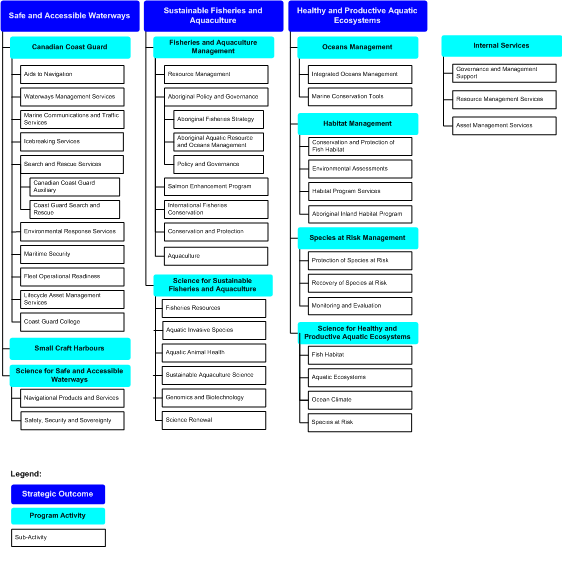
Program Activity Architecture: Long Description
DFO at a Glance
Our VisionExcellence in service to Canadians to ensure the sustainable development and safe use of Canadian waters |
Raison d'être
Canada's fisheries and oceans have played an important role historically, economically, and culturally in Canada's development and growth as a nation. Today, however, these fisheries and oceans face a number of challenges, including the collapse of key stocks, market changes, and environmental challenges such as pollution and climate change. In addition, DFO must be responsive to Aboriginal and treaty rights.
Fisheries and Oceans Canada (DFO) plays the lead role in managing and safeguarding Canada's aquatic resources. Ensuring safe, healthy, and productive waters and aquatic ecosystems for the benefit of present and future generations is the essence of the Department's activities. The Department's work is built around three strategic outcomes:
- Safe and Accessible Waterways — providing access to Canadian waterways and ensuring the overall safety and integrity of Canada's marine infrastructure for the benefit of all Canadians;
- Sustainable Fisheries and Aquaculture — delivering an integrated fisheries and aquaculture program that is credible, science based, affordable, and effective and contributes to sustainable wealth for Canadians; and
- Healthy and Productive Aquatic Ecosystems — ensuring the sustainable development and integrated management of resources in or around Canada's aquatic environment and carrying out critical science and fisheries-management activities.
| Strategic outcomes are the long-term and enduring benefits that Canadians derive from the Department's vision and efforts. |
DFO's Mandate
On behalf of the Government of Canada, DFO is responsible for developing and implementing policies and programs in support of Canada's scientific, ecological, social, and economic interests in oceans and fresh waters.
The Canadian Coast Guard (CCG), a Special Operating Agency within DFO, is responsible for services and programs that make a direct contribution to the safety, security, and accessibility of Canada's waterways. The Agency also contributes to the objectives of other government organizations through the provision of a civilian fleet and a broadly distributed shore-based infrastructure.
The Department's guiding legislation includes the Oceans Act, which charges the Minister with leading integrated oceans management and providing coast guard and hydrographic services on behalf of the Government of Canada, and the Fisheries Act, which gives the Minister responsibility for the management of fisheries, habitat, and aquaculture. The Department also shares, with Environment Canada and Parks Canada, responsibility for the Species at Risk Act, which charges the Minister with the responsibilities associated with the management of aquatic species at risk in Canada.
Strategic Outcome(s) and Program Activity Architecture
Like all federal government departments, DFO reports to Parliament on the basis of its Program Activity Architecture (PAA). The PAA explains the relationship between the activities the Department undertakes and the three strategic outcomes it is working to achieve. The PAA describes how the Department manages the resources under its control to achieve intended results/outcomes.
PAA Crosswalk
The Department's PAA for 2009-2010 differs only slightly from that used in the 2008-2009 Report on Plans and Priorities:
- In the 2008-2009 PAA, Aquaculture and Fisheries Management were separate program activities. In the new PAA, they are combined into a single program activity called Fisheries and Aquaculture Management.
- The 2009-2010 PAA also saw the addition of the new program activity, Species at Risk Management. In the 2008-2009 RPP, funding for this activity was included in the Habitat Management program activity.
- The sub-activity Species at Risk (Science) was moved from the Science for Sustainable Fisheries and Aquaculture program activity to the Science for Healthy and Productive Aquatic Ecosystems program activity.
The following shows resource allocations under the old and new PAAs.
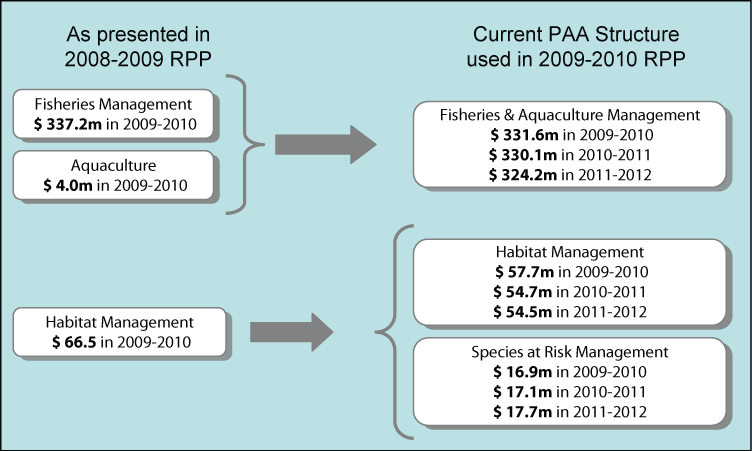
Program Activity Architecture: Long Description
Organization
Fisheries and Oceans Canada is a highly decentralized department, with more than eight of every ten employees located outside national headquarters. National headquarters, in Ottawa, establishes national objectives, policies, procedures, and standards for the Department, CCG, and six sectors — Fisheries and Aquaculture Management; Human Resources; Corporate Services; Oceans, Habitat and Species at Risk; Policy; and Science.
| For more information on how the Department is organized, see Organizational Structure. |
The Department's Regions
In addition to the National Capital Region, which serves as the Department's national headquarters, DFO has six regions, each headed by a Regional Director General (RDG).
Situated in regional headquarters, RDGs are responsible for delivering programs and activities in their regions in accordance with national and regional priorities and within national performance parameters. The Department operates fifteen regional science institutes, laboratories, and experimental centres across the country. Five DFO regions are home to CCG regional headquarters, which are headed by Assistant Commissioners responsible for the day-to-day delivery of Coast Guard services.
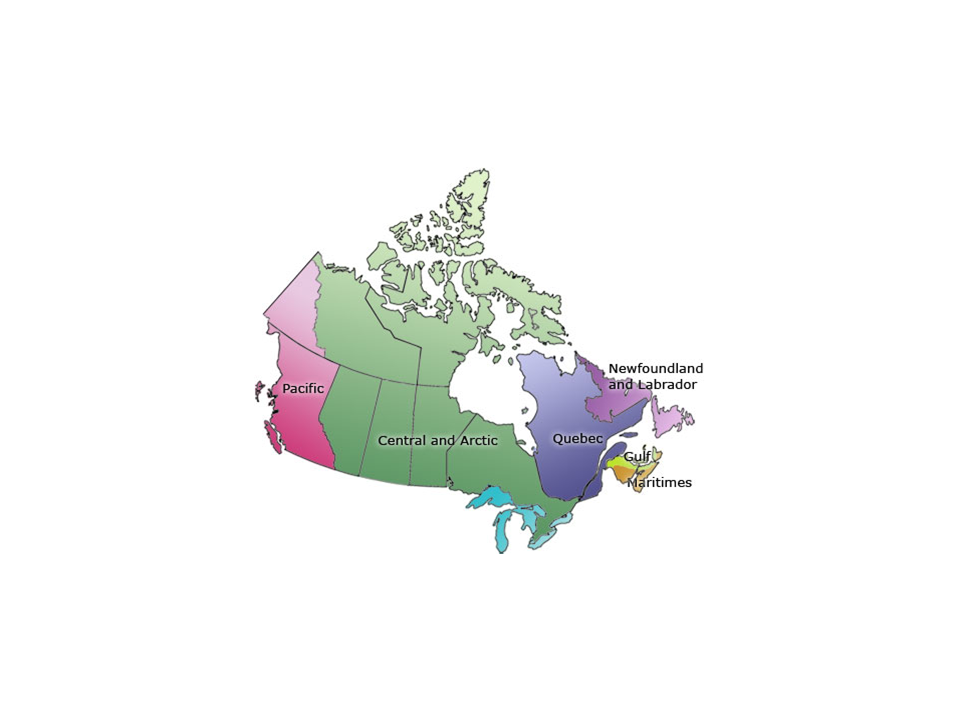
Newfoundland and Labrador
The Newfoundland and Labrador Region covers more than 28,900 km of coastline, 2.5m km2 of continental shelf, and three international boundaries. Almost 1,600 individuals, including 950 CCG personnel and over 180 Science personnel, deliver programs from regional headquarters in St. John's, three area offices, and about 40 detachment and satellite offices.
There are over 375 DFO-owned core fishing harbours in the region; these harbours, which are operated by Harbour Authorities, contain about 3,300 facilities. Regional CCG facilities include five Marine Communications and Traffic Services Centres, more than 1,700 fixed and floating aids to navigation, 55 lighthouses, and a fleet of 16 ships, 75 small craft, and three helicopters. Every year, the Maritime Rescue Sub-Centre in St. John's responds to about 500 incidents involving a total of 2,900 people.
| Newfoundland and Labrador Region has the most severe sea conditions in Canada, and its ice conditions are second in severity to those in the Canadian Arctic. |
Gulf
The Gulf Region includes all the waters of the Gulf of St. Lawrence adjacent to the eastern coast of New Brunswick, the Northumberland Strait coast of Nova Scotia and Western Cape Breton Island, and the whole of Prince Edward Island. Over 480 personnel serve Canadians from the regional office in Moncton, three area offices, and 20 field offices.
DFO owns 283 core fishing harbours in the Gulf and Maritimes regions, and Harbour Authorities in the Maritimes Region operate them.
The waters of this region represent about 1% of Canada's exclusive economic zone and account for approximately 20% of the total catch of Canada's fisheries. Gulf shares responsibility for the management of these fisheries with the Maritimes Region.
| Gulf is the only DFO region designated as bilingual: about half its staff are bilingual. |
Maritimes
The Maritimes Region extends from the northern tip of Cape Breton to the New Brunswick-Maine border, encompassing over 8,600 kilometres of coastline and adjacent marine areas. Approximately 2,400 full-time and seasonal staff work from the regional headquarters in Dartmouth, three area offices, and more than 100 other sites.
Harbour Authorities in the Maritimes Region operate the 283 DFO-owned core fishing harbours in the Gulf and Maritimes regions.
CCG activities for the region are administered from Dartmouth. CCG has operational bases in all three provinces, including three bases, nine search-and-rescue sites, three helicopter hangars, six helicopters, and 25 vessels.
The Canadian Hydrographic Service is responsible for hydrographic information for the entire Atlantic area, extending to the middle of the Canadian Arctic.
| The Maritimes Region is home to two renowned research stations: the Bedford Institute of Oceanography and the St. Andrews Biological Station. |
Québec
The Quebec Region, located within the borders of the province of Quebec, encompasses 6,000 kilometres of coastline. It consists of the St. Lawrence River, the estuary, and part of the Gulf, as well as the coastal waters of the Magdalen Islands. In Nunavik, it spans the eastern portion of James and Hudson Bay, the southern part of the Hudson Strait, as well as Ungava Bay.
This is the only unilingual French DFO region, and it has 1,400 employees, including 746 members of the CCG, distributed across 15 cities and communities.
With close to 4,000 commercial fish harvesters, the fishing industry remains an important economic engine for the marine sectors of Quebec. The region is home to 55 DFO-owned core fishing harbours, which are operated by Harbour Authorities.
The majority of programs and activities, including those of the CCG, are directed by the regional office, located in Québec City. The Maurice-Lamontagne Institute, a francophone marine science research centre located in Mont-Joli, is one of the most important federal science institutes in Quebec. Operating from 7 locations and assisted by a CCG Auxiliary of 656 members, CCG in the region operates a fleet of 24 vessels and aircraft.
| Over 70% of the population of Quebec resides along the St. Lawrence River up to the Gulf. This waterway, which extends 1,600 kilometres from the Atlantic Ocean to Montreal, has an impressive number of tributaries. Over 100 megatons of merchandise travel through the St. Lawrence River each year. |
Central and Arctic
DFO's largest region, Central and Arctic extends from Quebec to British Columbia — excluding the National Capital Region — and up through Canada's far north. It includes 71% of Canada's coastline, 67% of its fresh waters, and 65% of the country's marine waters. This region includes the Great Lakes, a key commercial and recreational waterway that supplies water to over 30 million people in Canada and the United States.
DFO shares some of its responsibilities for inland fisheries with the provinces and territories. Consequently, all regions work closely with the Department's provincial and territorial counterparts, as well as other resource management agencies, through formal partnerships, joint working arrangements, and shared work plans to ensure the effective understanding, management, and protection of aquatic ecosystems.
Some 1,500 individuals deliver programs from regional offices and the region's scientific research facilities. Central and Arctic's 600 CCG personnel, along with some 700 CCG Auxiliary members, deliver services from five Marine Communications and Traffic Services centres and almost 50 other CCG stations.
Harbour Authorities in Central and Arctic operate 54 DFO-owned core fishing harbours. Also, 7,100 fixed and floating aids to navigation help ensure that the region's waterways are safe and accessible.
| The region's fleet includes nine large vessels, 12 small vessels, three maritime security vessels, and two helicopters. Central and Arctic has operational control of six icebreakers from other regions during the Arctic navigational season. |
Pacific
The Pacific Region oversees 27,000 km of coastline, the inland fisheries of the Yukon Territory, 105 river systems in British Columbia, the rivers crossing the BC-Yukon border, and habitat in the BC interior; over 1,300 individuals work in the region's 40 offices and stations.
The 78 DFO-owned core fishing harbours in the Pacific Region are all operated by Harbour Authorities.
CCG Pacific Region is one of the largest regions in the Agency, with regional and fleet headquarters in Vancouver and Victoria respectively. Pacific Region's staff of more than 1,000 maintain and operate the region's many vessels, shore stations, helicopters, and marine aids.
| Science institutes include the Pacific Biological Station, the Institute for Ocean Sciences, the Center for Aquaculture and Environmental Research, and the Cultus Lake Salmon Research Laboratory. In addition, Pacific Region operates 14 major fish hatcheries. |
Strategic Context
To inform decisions on DFO's future directions, priorities, and business and human resources planning, the Department must take into account an increasingly complex and demanding policy and program environment that is characterized by interdependent domestic and global issues and risks.
DFO seeks to provide Canadians with the benefits of strong economic growth, knowledge and innovation, healthy environments, and safe and secure communities.
Economic growth that relies on a global economy necessitates marine trade. Safe and accessible waterways, modern navigation aids, hydrographic products and services, reliable small craft harbours, and collaborative partnerships with domestic and international stakeholders all contribute to this objective. Working with other nations to facilitate trade and marine commerce requires a sound strategy with regard to international engagement.
Healthy and productive aquatic ecosystems are the basis for sustainable fisheries and other marine enterprises that provide economic benefits for Canadians. Sustained use of our aquatic resources necessitates a thorough understanding of the resources and the ecosystems within which they exist, robust conservation and protection measures, and effective environmental response to emergencies. Continued work on the identification, protection, and recovery of species at risk is essential to maintaining the integrity and biodiversity of our aquatic ecosystems and the future sustainability of our resources.
Environmental impacts of climate change include changes in sea levels, changes in water characteristics, and diminishing ice cover. While this offers possibilities for emerging fisheries and off-shore natural resource development, it also presents risks to habitats and ecosystems and increases the threat posed by invasive aquatic species.
As Canada's Arctic is a maritime domain of territorial coasts, waterways, islands, and seas, DFO plays an important role in Northern economic development, sovereignty, and stewardship. Sea-ice depletion is changing the conditions for marine traffic and offers the prospect of new navigation routes in Canada's north, bringing about a need for new hydrographic data and navigational charts, new harbour facilities, and an increased presence to provide search and rescue and emergency environmental response.
The development of the Arctic's rich resource base requires both a broader scientific understanding and the protection of these unique ecosystems. Adapting to this combination of environmental and human impacts presents important challenges for many of the Department's program activities.
Being heavily reliant on global markets, Canada's seafood sector is directly affected by the weakening global economy. Decreasing access to capital for individuals and businesses affects who can participate in fisheries and influences the level and manner of that participation. Furthermore, an internationally competitive fishery must anticipate and adapt to market pressures, including technical trade standards such as eco-labelling and traceability and increasing competition from lower-cost international processors.
Global economic difficulties continue to put pressure on Canada's aquatic resources and make their conservation and protection even more important. Fisheries Renewal, with an emphasis on modernizing the Fisheries Act, will be a key priority of the Department. To capitalize on the economic benefits of our aquatic resources — both wild and farmed — we must work to ensure that Canadian fisheries products have access to increasingly restrictive global markets. Improving the governance of the aquaculture industry and providing market access are key priorities.
A safe marine environment and the provision of maritime services to Canadians, other federal departments, and other organizations helps to provide safe and secure communities, northern development, and arctic sovereignty. The Canadian Coast Guard, as a Special Operating Agency, focuses strongly on rejuvenation — replacing its aging infrastructure, improving management and maintenance, and focusing on its people — while continuing to provide service to Canadians, the Department, and others through a versatile fleet and shore-based infrastructure.
Recent scientific and technological innovations offer the potential for improvements in data acquisition and communications, while advances in fields such as resource extraction put more pressure on the Department to provide timely and reliable scientific support for environmental assessments.
Effective policies, programs, and resource management are all supported by knowledge of the oceans, inland waters, and aquatic species and ecosystems. Strong scientific research and monitoring programs are the basis of that knowledge. The Department's Science Program must ensure that its efforts are aligned with the information needs of the decision-makers of today and are able to adjust to emerging issues and the knowledge requirements of tomorrow.
Exponential growth in knowledge transfer and connectivity has fundamentally changed how people and organizations interact, requiring more openness, transparency, engagement, and accountability in the development and implementation of policies and programs. Collaborative partnerships with the provinces, territories, international interests, Aboriginal interests, and industry will allow the Department to meet its objectives while leveraging its resources. A sound strategy with regard to international engagement will allow Canada to work with other nations to protect shared resources.
The Department is committed to efficient and effective modern management — human resources modernization, business security and continuity, proactive information management, and strong asset management are all key to ensuring that the Department is able to provide results for Canadians.
Fisheries and Oceans Canada is committed to delivering effective and resilient programs and services that support environmentally sustainable and internationally competitive marine, fisheries, and aquaculture sectors; healthy aquatic ecosystems; and maritime safety and security. To respond to the potential risks and opportunities related to meeting this commitment, the Department will focus on the following priorities over the three-year planning period starting in 2009-2010.
| Key Operational Priorities | Ongoing Priorities |
|---|---|
|
|
| Management Priorities | |
|
|
Taken together, the Department's priorities support environmentally sustainable and internationally competitive fisheries, marine commerce, and healthy environments that contribute to the economic prosperity of our country. The Department is committed to designing and delivering its programs and services in a collaborative, transparent, and accountable manner.
Planning Summary and Departmental Priorities
| Departmental Planned Resources | |||
|---|---|---|---|
| 2009-2010 | 2010-2011 | 2011-2012 | |
| $ Millions | 1,858.9 | 1,983.3 | 2,010.2 |
| FTEs | 10,808 | 10,916 | 10,923 |
Future-oriented Financial Statements
As part of the government's commitment to implementing accrual budgeting and appropriations, DFO is participating in a pilot project to prepare future-oriented financial statements as a first step toward accrual budgeting. These forecasts will be aligned with the financial statements of the Departmental Performance Reports (DPRs), which are already prepared on an accrual basis, to permit meaningful comparison and analysis.
Departmental Planned Spending
The table showing the details of departmental planned spending by strategic outcome and program activities, along with the alignment to Government of Canada outcomes, can be found in the financial analysis at the end of this section. This placement permits a better discussion and explanation of the financial information contained in the table.
| For more Information, see DFO's future-oriented financial statements. | 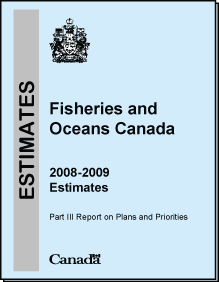 |
| Contribution of Operational Priorities to Strategic Outcomes | |
|---|---|
|
Fisheries Renewal
Fisheries Renewal is a three-year initiative to put in place policies, tools, and mechanisms to support a robust and diverse fisheries sector to benefit all Canadians. Fisheries Renewal is developing an enabling, transparent governance system to allow resource users and those with an interest in the resource to affect or to make decisions in support of their economic prosperity, while ensuring sustainability of the resource. In the long term, Fisheries Renewal will provide an integrated fisheries program that is credible, science-based, affordable, and effective and that contributes to sustainable prosperity for Canadians. |
Prior Commitment |
Key Operational Priority Contributing To:
|
Why
DFO is responsible for regulating harvesting activities to conserve the resource while providing sustainable economic opportunities. Key Plans
|
|
Northern Strategy
In support of the Government's Northern Strategy, DFO is working to develop an integrated approach to its role in Canada's Arctic. |
Prior Commitment |
Key Operational Priority Contributing To:
|
Why
Retreating polar ice, rising global demand for resources, and the prospect of year-round shipping are creating new challenges and opportunities for the North. DFO's activities play an important role in northern commerce, safety and security, sustainable resource development, and the understanding and protection of Arctic ecosystems and habitats. Key Plans
|
|
International Agenda
DFO's integrated approach to international fisheries and oceans identifies risks and opportunities globally, and influences the international agenda to protect and advance Canadian interests. DFO's international agenda seeks to ensure sustainable fisheries, the sustainability of marine environments and ecosystems, improved science-based decisions and policies, and international trade and business development throughout the fish and seafood value chain (fish harvesters, buyers/brokers, processors, marketing boards, distributors, and exporters). |
Prior Commitment |
Key Operational Priority Contributing To:
|
Why
DFO's international agenda is an area of growing importance. Increasingly, the international agenda influences domestic actions and presents opportunities to promote Canadian principles of sustainability. Key Plans
|
|
Health of the Oceans
Through its role in the Health of the Oceans initiative, DFO will support the establishment of a national system of Marine Protected Areas (MPAs), the designation of six new MPAs under the Oceans Act, additional science advice related to marine protection, the creation of four new virtual Oceans Centres of Expertise, and enhanced capacity to respond to oil spills in the Arctic Ocean. |
Prior Commitment |
Key Operational Priority Contributing To:
|
Why
DFO needs to strengthen its ability to prevent, detect, and reduce pollution; better protect ecologically significant marine areas; enhance co-operation with provincial/territorial, Aboriginal, domestic, and international partners; and better understand the oceans. The Government will also be increasing its scientific and conservation and protection activities in Canada's Arctic waters. Key Plans
|
|
Canadian Coast Guard Rejuvenation
CCG remains committed to delivering its services to mariners in Canadian waters by establishing clear, realistic priorities and ensuring sufficient resources are in place to deliver those services. |
Prior Commitment |
Ongoing Priority Contributing To:
|
Why
Coast Guard needs to continue to transform marine services through technology-based productivity improvements, client-service innovations, alternative service delivery, and greater use of partnering to secure a sustainable service-delivery model. Key Plans
|
|
Science Renewal
Science Renewal involves the development and implementation of initiatives that will ensure the Department's science base is aligned with the knowledge requirements of policy and decision-makers today while anticipating future science-based issues. The intent is to strengthen the ability of the Science Program to provide credible, relevant, and timely information to guide the development of policies and programs. |
Prior Commitment |
Ongoing Priority Contributing To:
|
Why
Timely, relevant, and valued science advice is needed to support public-policy development and decision-making within DFO and across all levels of government. Key Plans
|
|
Sustainable Aquaculture
Aquaculture continues to demonstrate tremendous potential for growth, as the global demand for fish and seafood exceeds the production capacity of wild fisheries. Sustainable Aquaculture will position the industry for enhanced profitability, self-sufficiency, and international competitiveness. |
Prior Commitment |
Ongoing Priority Contributing To:
|
Why
The Canadian aquaculture industry has the potential to become economically sustainable, environmentally responsible, and internationally competitive. Key Plans
|
|
Small Craft Harbours
The Small Craft Harbours (SCH) Program provides harbour infrastructure to the commercial fishing industry. |
Prior Commitment |
Ongoing Priority Contributing To:
|
Why
A safe and functional harbour infrastructure, combined with strong and viable local management of harbours, will over time increase the capacity to generate harbour revenues locally. This will in turn create socioeconomic benefits for the commercial fishing industry and local communities. Key Plans
|
|
Market Access
To maintain or increase market access, the export fish and seafood industry and government departments that regulate and enable their activities must now demonstrate, with supporting scientific evidence, that fish and seafood products are safe and are derived from sustainably managed and legal fisheries. The federal government must also ensure an adaptable, transparent, and predictable international framework of rules and standards that enables producers and consumers to have access to growing world markets. |
New Commitment |
Key Operational Priority Contributing To:
|
Why
The export fish and seafood industry is facing serious economic and environmental challenges in the form of new requirements for access to current and potential markets. Canada does not yet have in place the fully integrated traceability system needed to meet these requirements. Fish- and seafood-producing countries are facing an unprecedented number of international policy objectives that are being pursued through trade/market access measures (e.g., technical trade barriers). Negotiations are occurring in many parallel fora, and it is crucial that Canada take a lead in these negotiations to optimize access to markets for Canadian fish and seafood products, providing economic benefits and secure markets for our fisheries sector. Key Plans
|
|
Human Resources Modernization
Responding to the coming into force of all components of the new Public Service Modernization Act and the Public Service renewal plan of the Clerk of the Privy Council, the Department will work to modernize its human resource procedures to ensure that it has the right mix of human resources to deliver its programs and services. |
Prior Commitment |
Contributing To:
|
Why
The Department must respond to the coming into force of all components of the new Public Service Modernization Act (PSMA) and the government's Public Service Renewal Action Plan. Key Plans
|
|
Information Management and Information for Decision-making
DFO is establishing a five-year strategy for information management (IM). DFO is planning to adopt next-generation information solutions. The Department's vision for information is "Information used for decision-making and program delivery at DFO/CCG is accurate, relevant, comprehensive and timely." |
New Commitment |
Contributing To:
|
Why
This addresses the Government of Canada's priority of ensuring that high-quality and authoritative information is available for decision-makers. Key Plans
|
|
Asset Management
Modern aids to navigation, marine communications and traffic networks, vessels and other platforms, research facilities, shore installations, and small craft harbours are all costly assets that require special procurement, maintenance, and modernization. Many of these assets are nearing the end of their useful life or are at high risk of failure because of rust-out and capacity overload. |
Prior Commitment |
Contributing To:
|
Why
DFO has one of the largest capital asset bases of all federal departments and relies on an extensive and costly infrastructure to deliver its programs and services. Ensuring that this infrastructure meets departmental needs is critical to DFO's effectiveness. Key Plans
|
|
Security and Business Continuity
Under the leadership of DFO's Chief Information Officer, the IT Security Program ensures compliance with the spirit, intent, and mandated requirements of the Government Security Policy (GSP), the Government of Canada's Operational Security Standard: Management of Information Technology Security (MITS), and DFO's Integrated Risk Management Framework. Business Continuity Planning (BCP) helps ensure that Fisheries and Oceans will be able to continue to provide essential services to its clients and stakeholders even if the unexpected happens. In addition, the Emergency Management function works to provide appropriate responses to a wide variety of emergency situations. |
New Commitment |
Contributing To:
|
Why
In accordance with the Government Security Policy, the Departmental Security Officer (DSO) is responsible for all aspects of security and business continuity. DFO needs to protect employees, assets, information, and its IT infrastructure to satisfy Government of Canada security requirements and to ensure that Canadians have continued access to services. Key Plans
|
|
Partnering and Collaboration
Partnering and collaboration refers to collaborative arrangements between DFO and one or more parties (inside or outside government) where there is an explicit agreement to work cooperatively to achieve public-policy objectives. |
New Commitment |
Contributing To:
|
Why
DFO relies heavily on a broad range of suppliers, contractors, and third parties to support the delivery of its programs, and the Department continues to develop and sustain partnering arrangements that range from the very strategic to the very operational. Key Plans
|
Key Corporate Risks
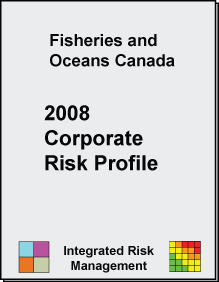

Key Corporate Risks: Long Description
DFO is committed to achieving its strategic outcomes and realizes that risks to those outcomes must be identified and mitigated as fully as possible. The Department has therefore developed and validated a corporate risk profile that identifies key risks and risk champions. The risk champions, members of the Departmental Management Committee, are accountable for risk mitigation, and identify risk-mitigation measures for each risk.
Risk champions determine the priorities for the risk-mitigation measures in their areas of responsibility; develop and coordinate the implementation of these measures; monitor the effectiveness of these measures; and ensure that risk management is integrated into planning and decision-making.
A fuller discussion of these risks and their mitigation strategy can be found in DFO's Corporate Risk Profile.
Expenditure Profile
| For the Main Estimates for all departments and agencies, see 2009-10 Part II - Main Estimates. | 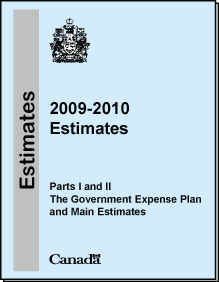 |
| Vote/Statutory Item (S) | Vote/Statutory Wording | 2009-2010 Main Estimates |
2008-2009 Main Estimates |
|---|---|---|---|
| 1 | Operating Expenditures | 1,167,689 | 1,178,250 |
| 5 | Capital Expenditures | 242,667 | 294,650 |
| 10 | Grants and Contributions | 110,637 | 90,461 |
| (S) | Minister of Fisheries and Oceans Canada salary and motor car allowance | 78 | 76 |
| (S) | Contributions to Employee Benefit Plans | 120,446 | 118,555 |
| Total - Fisheries and Oceans Canada | 1,641,517 | 1,681,992 | |
Departmental Planned Spending
| For program activity descriptions, please access the Main Estimates online. For more information on these outcome areas, see Canada's Performance, an annual report to Parliament. |  |
| Safe and Accessible Waterways |
Contributing to Government of Canada outcome areas :
|
|||
| Measured by: Public's confidence in the safety and security of marine travel in Canada | Target: 90% | |||
| (millions of dollars) | Forecast 2008-2009 | Planned 2009-2010 | Planned 2010-2011 | Planned 2011-2012 |
|
637.2 | 701.1 | 792.7 | 961.9 |
|
99.8 | 192.8 | 246.7 | 116.8 |
|
39.0 | 35.3 | 38.2 | 32.0 |
| Subtotal | 776.0 | 929.2 | 1,077.6 | 1,110.8 |
| Sustainable Fisheries and Aquaculture |
Contributing to Government of Canada outcome areas :
|
|||
| Measured by: Year over year improvement in management and conservation of major stocks to support sustainable fisheries, as evidenced in growth of the sustainability index | Target: 4% | |||
| (millions of dollars) | Forecast 2008-2009 | Planned 2009-2010 | Planned 2010-2011 | Planned 2011-2012 |
|
348.0 | 331.6 | 330.1 | 324.2 |
|
165.3 | 139.7 | 135.7 | 140.3 |
| Subtotal | 513.3 | 471.3 | 465.8 | 464.5 |
| Healthy and Productive Aquatic Ecosystems |
Contributing to Government of Canada outcome areas :
|
|||
| Measured by: The sustainable development and integrated management of resources in or around Canada's aquatic environment through oceans, fish habitat, and species at risk management | Target: TBD | |||
| (millions of dollars) | Forecast 2008-2009 | Planned 2009-2010 | Planned 2010-2011 | Planned 2011-2012 |
|
20.2 | 16.4 | 15.7 | 15.1 |
|
71.0 | 57.7 | 54.7 | 54.5 |
|
n/a | 16.9 | 17.1 | 17.7 |
|
58.5 | 55.4 | 54.4 | 50.0 |
| Subtotal | 149.6 | 146.4 | 142.0 | 137.3 |
|
367.4 | 311.9 | 297.9 | 297.6 |
| Total | 1,806.3 | 1,858.9 | 1,983.3 | 2,010.2 |
1 In 2008-2009, Species at Risk Management was part of Habitat Management.
Note: The Department continues to refine its Performance Measurement Framework to provide meaningful measures and targets.
Note: Because of rounding, figures may not add to the totals shown.
Analysis
With respect to the Departmental Planned Spending table:
- Adjustments to the Annual Reference Level Update (ARLU) figures due to amounts received in Supplementary Estimates, further policy approvals, Treasury Board approvals, Budget 2009, and statutory adjustments have been allocated to their respective program activities.
- Budget 2009 provided DFO with additional funding in 2009-2010 and 2010-2011 for:
- $175 million for Canadian Coast Guard vessel acquisition and repair and overhaul
- $200 million for Small Craft Harbours repair and maintenance
- $17 million to accelerate the construction of Pangnirtung harbour
- Forecast spending in 2008-2009 for Species at Risk Management shows as zero, as this program activity was created a separate entity for the 2009-2010 fiscal year. Previously, funds for this activity were included in the Habitat Management program activity.
- The increases for funding for Small Craft Harbours in 2009-2010 and 2010-2011 represent funding for small craft harbour repair and maintenance throughout the country and funding for Pangnirtung harbour in support of Nunavut's emerging fisheries.
- The increase for funding for Canadian Coast Guard in 2009-2010 and 2010-2011 represents funding for fleet renewal, including funds to repair and overhaul 40 large vessels and to acquire a large number of new vessels, including 60 small crafts, 30 replacement environmental response barges, 5 lifeboats, and 3 replacement inshore science vessels.
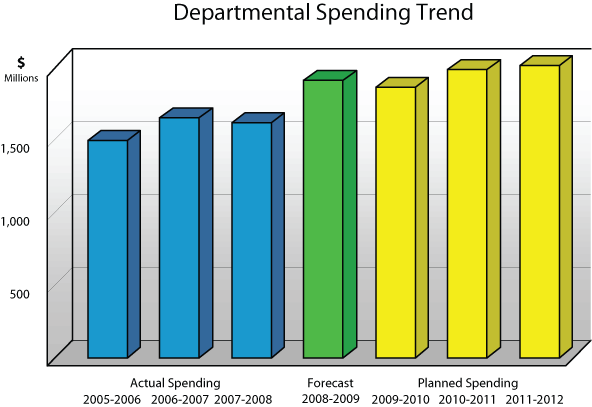
Departmental Spending Trend: Long Description
As the accompanying graph, Departmental Spending Trend, shows, departmental spending has remained fairly constant in recent years but will rise slightly between now and 2011 2012. This increase is due largely to new funding in the Safe and Accessible Waterways strategic outcome for fleet renewal for the Canadian Coast Guard and for enhanced small craft harbour maintenance and repair programs.
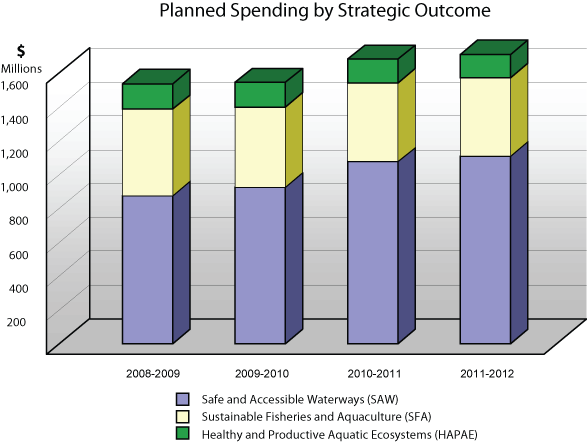
Planned Spending by Strategic Outcome: Long Description
The Planned Spending by Strategic Outcome graph clearly illustrates the increase in funding for Safe and Accessible Waterways.
The pie charts below compare the manner in which funds were allocated to strategic outcomes in 2008-2009 and 2009-2010. The allocation remained relatively constant, with the slight change in percentages being explained by the increased funding for Safe and Accessible Waterways noted above.
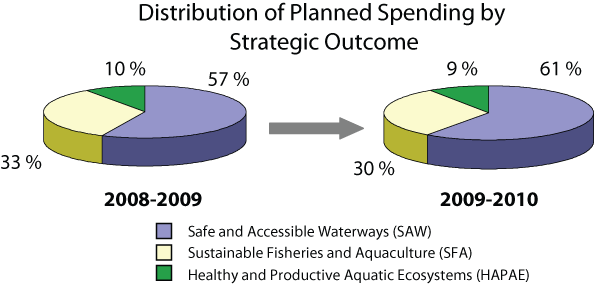
Distribution of Planned Spending by Strategic Outcome: Long Description
Note: In previous years, funding for the Internal Services program activity was identified under Program Enablers, and this funding was allocated to each of the Department's strategic outcomes. In line with new Treasury Board Secretariat directives, this funding is now displayed as a separate program activity independent of individual strategic outcomes, as it supports all of them.
Section II: Analysis of Program Activities by Strategic Outcome(s)
In this Section
- Safe and Accessible Waterways
- Sustainable Fisheries and Aquaculture
- Healthy and Productive Aquatic Ecosystems
Safe and Accessible Waterways
| Resources | 2009-2010 | 2010-2011 | 2011-2012 |
|---|---|---|---|
| $ Millions | $929.2 | $1,077.6 | $1,110.8 |
| FTEs | 5,192 | 5,206 | 5,059 |
| Description | Providing access to Canadian waterways and ensuring the overall safety and integrity of Canada's marine infrastructure for the benefit of all Canadians. | ||
| Measure | Public's confidence of the safety and security of marine travel in Canada | ||
| Target | 90%2 | ||
2 Because of changes in data availability, this indicator is currently under review.
Safe and Accessible Waterways contributes to these Government of Canada outcome areas:
|
Safe and Accessible Waterways provides Canadians with economic benefits and contributes to safe and secure communities. The fisheries, marine commerce, international trade, recreational fishing and boating, and tourism all depend on waterways, aids to navigation, communications services, hydrographic information, and safe and sustainable harbours. Search and rescue, icebreaking services, and an on-water presence are integral parts of Canada's safety, security, and sovereignty. These benefits are delivered by:
- Canadian Coast Guard
- Small Craft Harbours
- Science for Safe and Accessible Waterways
Changes in climate, marine technologies, environmental conditions, capital asset requirements and costs, and maritime traffic levels continually challenge our ability to ensure that Canada's marine trade corridors and waterways remain safe and accessible for maritime commerce and recreation.
The Government of Canada's commitment to and focus on the North places further demands on DFO. As the federal government's maritime service provider, CCG has a critical role to play in supporting DFO and other federal departments in realizing their objectives and goals for the North, and in protecting and securing Canada's sovereignty in the Arctic region.
Also affecting the Department is CCG's evolving role in maritime security. This is increasing the need for strategic partnering to improve marine security, maritime domain awareness, vessel-tracking capabilities, and on-water security capacity.
The national system of harbours protects many millions of dollars invested in fishing vessels and equipment, prevents coastal erosion and damage, supports local economic development and employment, and offers refuge for mariners in distress.
The SCH Program currently provides commercial fishing harbour services in all provinces and territories but Nunavut and the Yukon.
The Department's Science Program, through the Canadian Hydrographic Service (CHS), provides hydrographic and ocean-science products and services that support Canada's maritime transportation infrastructure, safe navigation, security, and sovereignty. Keeping existing hydrographic charts up-to-date while creating new ones is an ongoing challenge. The advent of electronic charts and other technological advances, such as multi-beam data collection, continue to change how CHS makes hydrographic information available to Canadians.
| Canadian Coast Guard | Program Activity |
|---|
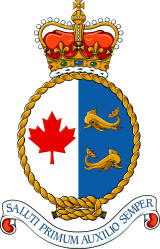 |
Description: The Canadian Coast Guard delivers civilian marine services (vessels, aircraft, expertise, personnel and infrastructure) on behalf of other federal government departments or in support of federal agencies and organizations in the achievement of their own specific Government of Canada maritime priorities. CCG provides support to other parts of Fisheries and Oceans Canada (Science and Conservation and Protection), the Department of National Defence, Environment Canada, the Royal Canadian Mounted Police, the Department of Foreign Affairs, and Transport Canada among others. |  |
| Resources and Results | 2009-2010 | 2010-2011 | 2011-2012 |
|---|---|---|---|
| $ Millions | $701.1 | $792.7 | $961.9 |
| FTEs | 4,778 | 4,778 | 4,778 |
| Expected Result | Safe, economical and efficient movement of maritime traffic in Canadian waters | ||
| Percentage of traffic accidents vs. vessel clearances | |||
| Expected Result | Minimize loss of life or injury resulting from marine incidents | ||
| Confidence in the Canadian Coast Guard's ability to deliver SAR Services | |||
| Expected Result | Minimize impacts of ship source oil spills in Canadian waters | ||
| Confidence in the Canadian Coast Guard's ability to deliver ER Services | |||
| Expected Result | Civilian fleet operationally ready to deliver Government of Canada programs and maintain a federal presence | ||
| The extent to which CCG is meeting Government of Canada requirement for an operationally ready fleet | |||
| CCG has committed to consulting with clients and stakeholders and adjusting its Performance Measurement Framework, where required. As a proxy, CCG will assess its performance against the extent to which all sub activity targets are met | |||
Note: These figures include Treasury Board adjustments and funding announced in the 2009 Federal Budget.
Key Priority: Canadian Coast Guard Rejuvenation
Canadian Coast Guard Rejuvenation aims to make meaningful progress in areas related to client service, the effective and efficient delivery of CCG programs and services, and CCG's workforce.
| Key plans and commitments related to CCG Rejuvenation are further detailed in the CCG Business Plan, published annually, each June. | 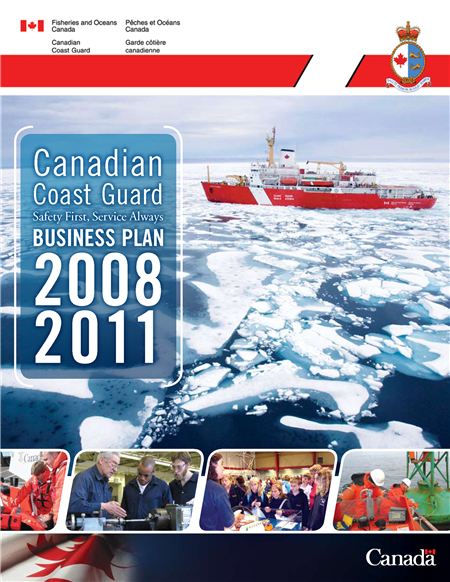 |
Key Initiative: Focus on Client Service
CCG is working to improve client service by reviewing its levels of service with client groups. In 2007-2008, an examination of CCG's Levels of Service and Service Standards began, with over 30 client consultation sessions. In 2009-2010, CCG will revise the Levels of Service and Service Standards document, taking into account the analysis of comments received from clients in previous years. CCG will also continue to refine Service Level Agreements with internal clients.
CCG provides platforms and assets to support government priorities and other government departments in the areas of maritime security, Canada's Northern Strategy, and the environment.
| 2009-2010 | 2010-2011 |
|---|---|
|
|
|
|
|
|
|
|
|
|
|
Key Initiative: Focus on Effectiveness and Efficiency
To ensure the effective and efficient delivery of its programs, CCG is renewing its fleet and shore-based assets via improved lifecycle asset management and a 25-year Fleet Renewal Strategy. Unfortunately, the construction of 12 mid-shore patrol vessels, approved in federal budgets since 2005, has been delayed because the bids received exceeded the funds allocated. In 2009-2010, CCG will work with Public Works and Government Services Canada to re-issue the Request for Proposal, with the goal of awarding a contract to the successful bidder.
Budgets 2006 and 2007 also provided resources for the purchase of three off-shore fisheries science vessels and one off-shore oceanographic science vessel, and Budget 2008 provided for a new Polar Class icebreaker to replace CCGS Louis S. St-Laurent. Work toward the delivery of the science vessels and the icebreaker will continue in 2009-2010 through 2011-2012.
Budget 2009 provides additional funding of $175 million for the purchase of 98 small craft (including 30 replacement environmental response barges); a number of new vessels, including three inshore science vessels (to replace existing vessels); as well as funds to repair and overhaul 40 large vessels. These investments will enhance fleet renewal and vessel maintenance initiatives and will strengthen our overall capacity, particularly in Search and Rescue and in environmental response across the country.
To strengthen the linkages among its strategic vision, long-term capital plans, and in year budget allocations, CCG will put in place an Integrated Infrastructure Investment Plan.
CCG is also taking steps to innovate or update technologies. For example, Aids to Navigation of the 21st Century (AToN21) considers the changing navigational needs of users, ensuring that the right mix of aids to navigation is available, and lays the foundation for an efficient and effective service. The Agency is also moving toward one system for the management of vessel traffic.
CCG's efforts to strengthen management will further enhance effectiveness and efficiency. Coast Guard will continue to work toward national consistency in planning, reporting, and management practices. A key commitment in this area includes the development of a Strategic Program Framework that will result in the systematic examination of the six Maritime Services programs to ensure that they focus on key priority areas. Work will also continue on the implementation of recommendations of CCG's 2007-2008 Vessel Maintenance Management Review, which was conducted in response to findings of the February 2007 Report of the Auditor General.
| 2009-2010 | 2010-2011 | 2011-2012 |
|---|---|---|
| Renewing the Fleet and Shore-based Assets | ||
|
|
|
|
|
|
|
|
|
|
||
|
||
| Modernization through Innovation and Technology | ||
|
||
|
||
|
||
| Strengthening Management | ||
|
||
|
Implement the CCG Vessel Maintenance Management Framework | |
|
Implement the CCG Vessel Condition Continuous Survey Program | |
Key Initiative: Focus on People
Like many other organizations, Coast Guard faces an increasingly competitive labour market. For example, CCG needs to retain highly skilled mariners, as well as other technical and operational specialists, and it needs to recruit new staff because of upcoming retirements.
In 2008-2009, the Agency continued to strengthen its capacity for succession planning by integrating human resource and corporate business planning, with an emphasis on improving diversity. Through 2009-2010 and beyond, CCG will focus on attracting and retaining a skilled workforce, improving the diversity of its workforce, providing training and development for staff, and ensuring national consistency in human resource management.
| 2009-2010 | 2010-2011 | 2011-2012 |
|---|---|---|
|
|
|
|
||
|
| Small Craft Harbours | Program Activity |
|---|
Description: The Small Craft Harbours Program directly, or indirectly through Harbour Authorities, operates and maintains a network of harbours, critical to the fishing industry, open, safe and in good repair. These harbours are necessary for the effective operation of the commercial fisheries that contribute to the Canadian economy, directly support employment, and indirectly create tens of thousands of jobs, many in rural and isolated parts of Canada.
| Resources and Results | 2009-2010 | 2010-2011 | 2011-2012 |
|---|---|---|---|
| $ Millions | $192.8 | $246.7 | $116.8 |
| FTEs | 133 | 147 | 147 |
| Expected Result | A network of harbours critical for Canada's commercial fishing industry that is open, safe, and in good repair | ||
| Percentage of core fishing harbours with performance ratings of fair, good or very good | |||
| 70% | 70% | 70% | |
| Percentage of facilities at core fishing harbours in fair, good or very good condition | |||
| 80% | 80% | 80% | |
| Percentage of core fishing harbours that have Environmental Management Plans in place | |||
| 95% | 95% | 95% | |
| Expected Result | HAs are able to effectively manage and maintain core commercial fishing harbours | ||
| Percentage of existing core fishing harbours managed by HAs | |||
| 90% | 90% | 90% | |
| Expected Result | Recreational and non-essential fishing harbours are divested | ||
| Percentage of recreational and non-core harbours divested | |||
| 5% divested | 5% divested | 5% divested | |
Note: These figures include Treasury Board adjustments and funding announced in the 2009 Federal Budget.
Budget 2009 provided Small Craft Harbours with additional funding in 2009-2010 and 2010-2011 to invest in harbour repair, maintenance, and dredging at core fishing harbours ($200 million) and to accelerate the construction of a fishing harbour in Pangnirtung, Nunavut ($17 million).
Key Priority: Supporting the Northern Strategy
Fishing harbours continue to be the most critical public infrastructure of the fisheries and seafood sector. While Nunavut's commercial fishery is currently in its developmental stage, DFO and the Government of Nunavut have jointly assessed the Territory's infrastructure needs. The assessment advised that seven community harbours were warranted to facilitate the Territory's commercial fisheries and to support other regional interests.
| Link to Northern Strategy priority here (in priorities table) |
Key Initiative: Pangnirtung Harbour, Nunavut
Budget 2008 announced funding for a community harbour in Pangnirtung, Nunavut. This initiative is supported by the Science Sector's initiative to provide hydrographic support for the harbour ("Key Initiative: Hydrographic Data and Products in Support of Pangnirtung Harbour,") and by aids to navigation provided by the Canadian Coast Guard.
| 2009-2010 | 2010-2011 | 2011-2012 |
|---|---|---|
|
|
|
Key Priority: Small Craft Harbours
The SCH Program provides harbour infrastructure to the commercial fishing industry. A safe and functional harbour infrastructure, combined with strong and viable local management of harbours, will over time increase the capacity to generate harbour revenues locally. This will in turn create socioeconomic benefits for the commercial fishing industry and local communities.
To achieve this, the Program continues to address harbour rust-out and the changing needs of the industry. While funding pressures have been managed so far, the current structure of the Program is not sustainable in the long run. DFO will therefore investigate ways to help ensure the sustainability of the SCH Program by developing and implementing proposals for Program sustainability and continuing to divest non core fishing and recreational harbours.
Harbour Authorities are facing increasing demands for services, while experiencing low support and low turnover of volunteers. Without Harbour Authorities, SCH would be unable to maintain and operate its network of harbours. The Program must therefore develop ways to support this important group of volunteers.
Key Initiative: Sustainable Harbours
Small Craft Harbours is developing proposals for making the Program more sustainable, along with ways to reduce rust-out and address lifecycle management and investment needs. The proposals will include both what can be accomplished within existing resource levels and what can be achieved with additional funding.
| 2009-2010 | 2010-2011 | 2011-2012 |
|---|---|---|
|
|
Key Initiative: Sustainable Harbour Authorities
The Program is developing tools and training packages to support the sustainability and viability of Harbour Authorities. This includes developing a compendium of competencies, a Harbour Authority Maintenance Manual, tools to provide guidance for setting and collecting fees, and tools for use by Harbour Authority Boards of Directors.
| 2009-2010 | 2010-2011 | 2011-2012 |
|---|---|---|
|
|
|
| Science for Safe and Accessible Waterways | Program Activity |
|---|
| Description: This program provides scientific research, monitoring, advice, products and services and data management to ensure departmental and federal policies, programs, decisions, and regulations associated with safe, secure, and accessible waterways are informed by science advice. The science is provided through a network of research facilities, in collaboration with other government departments, private sector, academia and international organizations. | 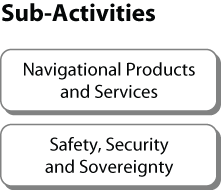 |
| Resources and Results | 2009-2010 | 2010-2011 | 2011-2012 |
|---|---|---|---|
| $ Millions | $35.3 | $38.2 | $32.0 |
| FTEs | 281 | 281 | 281 |
| Expected Result | Stakeholders have the information to safely navigate Canada's waterways | ||
| Number of navigational digital and paper products sold | |||
| Increase digital navigational charts to converge with paper chart production year over year | |||
Key Priority: Supporting the Department's International Agenda
Key Initiative: United Nations Convention on the Law of the Sea
The ratification of the United Nations Convention on the Law of the Sea (UNCLOS) in 2003 requires Canada to submit evidence within ten years to the United Nations Commission on the Limits of the Continental Shelf in support of its territorial claim to the continental shelf beyond the current 200-mile Exclusive Economic Zone.
The Canadian Hydrographic Service (CHS) is responsible for completing bathymetric survey work in support of Canada's submission of evidence to the United Nations Commission on the Limits to the Continental Shelf (UNCLCS).
This work is concentrated in three areas: the Western Arctic (Beaufort Sea and Canada Basin), Eastern Arctic (Alpha and Lomonosov Ridges), and the Atlantic Ocean from the Labrador Sea to the United States border. The greatest challenges to bathymetric data collection have been experienced in the Arctic. Finalizing DFO's contribution to the submission requires three more years of survey work.
| 2009-2010 | 2010-2011 | 2011-2012 |
|---|---|---|
|
||
|
||
|
||
|
||
Key Priority: Supporting the Northern Strategy
Key Initiative: Hydrographic Data and Products in Support of Pangnirtung Harbour
CHS will provide hydrographic support for the design of the harbour facility in Pangnirtung, Nunavut, as well as updates to nautical products once the harbour is established. Initial data needs include information on tides, currents, and near-shore bathymetry.
As the new harbour nears completion, CHS will verify depth information in dredged areas and near new structures. Once the facility is operational, CHS will maintain all relevant navigational publications, including charts, sailing directions, and tide tables.
| Bathymetry is the study of the underwater depths of lakes or ocean floors. A bathymetric map or chart usually shows floor relief or terrain and may provide information on surface navigation. |
| 2009-2010 | 2010-2011 | 2011-2012 |
|---|---|---|
|
||
|
||
|
||
Sustainable Fisheries and Aquaculture
| Resources | 2009-2010 | 2010-2011 | 2011-2012 |
|---|---|---|---|
| $ Millions | $471.3 | $465.8 | $464.5 |
| FTEs | 2,559 | 2,608 | 2,615 |
| Description | Delivering an integrated fisheries and aquaculture program that is credible, science based, affordable, and effective, and contributes to sustainable wealth for Canadians | ||
| Measure | Year over year improvement in management and conservation of major stocks to support sustainable fisheries, as evidenced in growth of the sustainability index (baseline 5.4 out of 10)3 | ||
| Target | 4% | 3% | 2% |
3 This baseline is preliminary, as it is based on an incomplete data set for 2008. Resource Management will have a final number for 2008 by the end of March 2009. We expect a declining increase over time as more management tools and measures to support sustainability are put in place and improvements in fisheries outcomes are realized. It will be harder to close the final gap - to make those final, most challenging improvements.
Sustainable Fisheries and Aquaculture provides Canadians with economic benefits from our aquatic natural resources. Ensuring that these products have access to world markets and working with other nations to protect and conserve the resources is critical. The Department seeks to maximize the socioeconomic benefits to Canadians arising from recreational fisheries and First Nations fisheries. Understanding and managing the complex ecosystems to allow these benefits to accrue in a sustainable fashion is the work of:
- Fisheries and Aquaculture Management
- Science for Sustainable Fisheries and Aquaculture
Sustainable Fisheries and Aquaculture contributes to these Government of Canada outcome areas:
|
Canada's commercial fishery is characterized by a multitude of small operators and a handful of large, vertically integrated companies that continually face challenges that are a complex mix of biological, economic, and social factors. The viability of many coastal communities is directly linked to the health of the fisheries. New technologies have made it easier to catch and process far more fish than can be harvested sustainably. The recreational fishery, with direct annual expenditures of $7.5 billion, is an important contributor to the Canadian economy.
Precautionary and ecosystem approaches support resource sustainability and economic prosperity for commercial, Aboriginal, and recreational fish harvesters, with the common goal of a sustainable, economically viable, internationally competitive industry. DFO continues to work with others to develop recovery strategies, make adjustments to fisheries facing serious challenges, and develop a conservation ethic that values long-term objectives for the resource over short-to-medium-term social or economic goals.
Canada's aquaculture industry is characterized by a substantial yet largely unrealized growth potential. The industry consists of many small and medium-sized companies, as well as a few large ones. Both the medium-sized and large companies are often partially vertically integrated. Aquaculture supports the viability of a growing number of coastal and Aboriginal communities, providing mostly year-round and relatively well-paid jobs.
DFO's vision for aquaculture is to create the conditions necessary for the development of a sustainable and environmentally responsible aquaculture sector in Canada. This requires a streamlined regulatory environment, harmonized standards and practices, and enhanced public confidence in the sector.
Sound science provides the basis for informed decision-making and an innovative and knowledge-based economy. Departmental priorities associated with Fisheries Renewal, the international agenda, and sustainable aquaculture require scientific support to ensure that the associated policies, programs, and regulations have a sound basis in the natural sciences.
| Fisheries and Aquaculture Management | Program Activity |
|---|
| Description: The overall goal of fisheries and aquaculture management is the conservation of Canada's fisheries resources to ensure sustainable resource utilization through close collaboration with resource users and stakeholders based on shared stewardship. Fisheries and Aquaculture Management is responsible for international fisheries conservation negotiations and relations, shared management of interception fisheries in international waters, management of the Aboriginal, commercial, recreational fishing in the coastal waters of Canada's three oceans and creating the conditions for a vibrant and innovative aquaculture industry. | 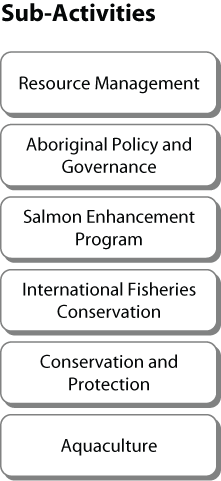 |
| Resources and Results | 2009-2010 | 2010-2011 | 2011-2012 |
|---|---|---|---|
| $ Millions | $331.6 | $330.1 | $324.2 |
| FTEs | 1,554 | 1,600 | 1,607 |
| Expected Result | Sustainable fisheries and aquaculture | ||
| Year over year improvement in management and conservation of stocks to support sustainable fisheries, as evidenced in growth of the sustainability index | |||
| 4% | 3% | 2% | |
Note: These figures include Treasury Board adjustments and funding announced in the 2009 Federal Budget.
Key Priority: Fisheries Renewal
Fisheries Renewal is focusing on revising programs and policies that are preventing sectors from generating maximum benefits from limited resources. Positive changes have been made in pursuit of a Fisheries Renewal agenda that supports a modern, self-reliant, stable, and adaptable harvesting sector. Nevertheless, more work is required to consolidate, entrench, and build on these advances.
Fisheries Renewal is a three-year initiative to put in place policies, tools, and mechanisms to support a robust and diverse fisheries sector - a sector that includes a broad range of resource users (Aboriginal, recreational, or commercial) and has a role for organizations and individuals interested in the outcomes of fisheries decision-making.
Fisheries Renewal is founded on a strong policy renewal platform and builds on DFO's context and commitments. It has developed out of recent policy initiatives across the country, from a variety of regional fisheries management approaches, from international commitments, and from stricter market requirements.
A key objective of Fisheries Renewal is to develop an enabling, transparent governance system to allow resource users and others involved with the resource to affect or to make decisions in support of their economic prosperity while ensuring the sustainability of the resource.
Fisheries Renewal also aims to deliver an integrated fisheries program that is credible, science-based, affordable, and effective and that contributes to economic prosperity for Canadians. This will be achieved by helping DFO and resource users meet conservation objectives; enabling resource users to effectively respond to the economic forces that affect their industry; increasing stability, transparency, and predictability in fisheries management; and modernizing the legislative framework that governs fisheries management.
The sensitive benthic areas policy, the forage species policy, the fishery checklist (a self-diagnostic tool), and the new integrated fisheries management plan template are examples of this ongoing work.
| Benthic species are organisms that live on the seabed and the bottom of rivers and lakes, including organisms that live in and on sediments or inhabit rocky substrata. Forage species are small aquatic species that larger predators prey on. |
Key Initiative: Atlantic Integrated Commercial Fisheries Initiative
The Atlantic Integrated Commercial Fisheries Initiative (AICFI) has been developed to achieve sustainable, integrated fisheries in which all participants fish under common and transparent rules. AICFI will help participating First Nations communities develop their commercial fishing enterprises and co-management capacity so they can manage their fishing enterprises and maximize the potential value of access to the fishery. These rights were obtained through the Marshall Response Initiative, which was completed on March 31, 2007.
| 2009-2010 | 2010-2011 | 2011-2012 |
|---|---|---|
|
|
|
|
|
|
Key Initiative: Pacific Integrated Commercial Fisheries Initiative
The Pacific Integrated Commercial Fisheries Initiative (PICFI) responds to the conservation and sustainability challenges facing Pacific fisheries and the need for greater co-operation among fish harvesters. The initiative is central to fisheries reforms that will secure the long-term sustainability and economic viability of Pacific fisheries while supporting First Nations' aspirations for greater participation in integrated commercial fisheries and fisheries management.
Through this initiative, DFO is seeking to advance common and transparent rules for all commercial fisheries; to strengthen accountability through improved catch monitoring, data reporting, and compliance; and to improve traceability measures. In addition, demonstration fisheries are being undertaken to explore new approaches to managing fisheries, including share-based management of salmon fisheries.
| 2009-2010 | 2010-2011 | 2011-2012 |
|---|---|---|
|
|
|
|
|
Key Priority: Sustainable Aquaculture
Aquaculture in Canada now accounts for about 33% of the total value of Canadian fish and seafood production. The sector continues to demonstrate tremendous potential for growth, as global demand for fish and seafood continues to exceed the production capacity of wild fisheries. The Canadian aquaculture industry has, however, expanded much more slowly than its international competitors.
DFO's goal is to stimulate substantial growth in the industry in a sustainable manner by reducing or removing constraints on development and creating the conditions necessary for a successful aquaculture industry.
For the industry to become internationally competitive and environmentally and socially sustainable, strong federal leadership is required in governance and regulatory reform, scientific research in support of sustainable production, innovation, and certification and market access.
Key Initiative: The Aquaculture Program Initiative
This initiative seeks to create the conditions necessary for the success of the Canadian aquaculture sector by reducing some of the key constraints it currently faces. This will be accomplished through regulatory and policy reform, as well as direct contributions to spur innovation and investments by the industry.
A renewed governance for the implementation of the aquaculture program consists of the Departmental Aquaculture Management Committee and the Departmental Aquaculture Operations Committee. Coordination across provinces and territories with the federal government is enhanced by the Interdepartmental Committee on Aquaculture and the Canadian Council of Fisheries and Aquaculture Ministers Task Group. Co-ordination with industry is achieved through the Aquaculture Industry Liaison Committee. Achieving the governance objectives also requires support from the Science sector in providing research and advice.
| 2009-2010 | 2010-2011 | 2011-2012 |
|---|---|---|
|
||
Key Priority: Market Access
The seafood sector is facing serious economic challenges in the form of new requirements for access to current and potential markets. Strong market access supports a self-reliant industry and economic prosperity. To maintain or increase market access, the export seafood industry and government departments that regulate and enable industry activities must now demonstrate, with supporting evidence, that fish and seafood products are safe and are derived from sustainably managed and legal fisheries.
| Traceability, in relation to the seafood industry, is the ability to trace fishery products through the harvesting, processing, and retail stages to demonstrate that the products originate in fisheries that are sustainably managed and legal. |
Canada does not currently have in place a fully integrated traceability system for meeting these requirements. This has generated considerable concern from provincial counterparts and industry stakeholders. If this situation persists over the longer term, Canada will lose market share.
DFO will make changes to the management of our fisheries to support market access through legislation, regulation, policy, negotiations, and increased advocacy efforts with others along the seafood value chain. DFO will work to create the necessary conditions to maintain and improve market access, thus optimizing economic benefits and increasing stability in our fisheries sector.
| The seafood value chain consists of fish harvesters, buyers/brokers, processors, marketing boards, distributors, and exporters. |
DFO is developing a Market Access Action Plan to explore the Department's evolving role in addressing current and emerging seafood market access pressures. The Department, along with other federal government departments, provinces, and territories, is working on supporting industry to meet the current and emerging domestic and international requirements — eco-certification and concerns with food safety — by developing and implementing an integrated traceability strategy and system.
| Science for Sustainable Fisheries and Aquaculture | Program Activity |
|---|
| Description: Provision of advice and recommendations based on scientific research and monitoring, as well as the provision of products and services and the management of data on Canada's oceans and resources. This ensures departmental and federal policies, programs, decisions, and regulations associated with sustainable fisheries and aquaculture are informed by scientific knowledge. The science is provided through a network of research facilities, in collaboration with other government departments, private sector, academia and international organizations. | 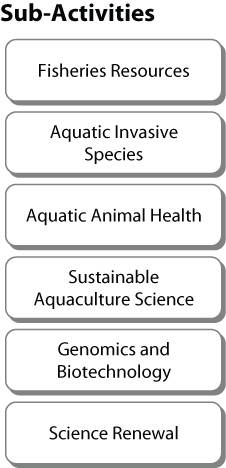 |
| Resources and Results | 2009-2010 | 2010-2011 | 2011-2012 |
|---|---|---|---|
| $ Millions | $139.7 | $135.7 | $140.3 |
| FTEs | 1,006 | 1,009 | 1,009 |
| Expected Result | Comprehensive understanding of living aquatic resources | ||
| Number of requests for science advice on living aquatic resources | |||
| Complete 90% of requests for science advice on living aquatic resources that senior management approves | |||
| Number of Canadian Science Advisory Secretariat (CSAS) publications on living aquatic resources that are posted on the DFO web site | |||
| Maintain 5-year average | |||
| Number of publicly available products on living aquatic resources completed by DFO Science | |||
| Maintain 5-year average | |||
Note: These figures include Treasury Board adjustments and funding announced in the 2009 Federal Budget.
Key Priority: Science Renewal
The Government of Canada continues to make significant investments in science and technology. The policy direction provided in Canada's new Science and Technology Strategy: Mobilizing Science and Technology to Canada's Advantage underscores the importance of scientific information and advice in support of public policy development and decision-making. Recent investments in science in support of sustainable aquaculture, fisheries science research, and seabed mapping in support of Canada's submission to the United Nations Commission on the Limits of the Continental Shelf are vital to the delivery of DFO's priorities.
Given this supporting role, the Department's Science Program must ensure that its efforts are aligned with the needs of decision-makers today while being strategically prepared to meet the requirements of tomorrow.
Key Initiative: International DFO Science Strategy
The collaborative nature of scientific endeavours puts science in a unique position to both support and influence international relationships and to leverage science resources. To maximize the contribution of the Science Program in the international arena, the Department will develop an International Science Strategy with the specific objectives of:
- Leveraging finite science resources and building capacity through strategic alliances with international leaders in priority science areas
- Supporting the attainment of DFO's policy and management objectives regarding international fisheries and oceans
- Supporting Canada's international science and technology objectives
- Supporting Canada's foreign policy and trade objectives
| 2009-2010 | 2010-2011 | 2011-2012 |
|---|---|---|
|
||
Key Initiative: Implementation of the Multi-year Strategic and Operational Planning Framework
To ensure a comprehensive approach to the renewal of the Science Program, we have completed an overarching multi-year strategic and operational planning framework that provides direction on the way forward and links the various enabling strategies, plans, and initiatives under the Science Renewal priority.
While the Framework is complete, the strategies, plans, and initiatives associated with the Framework are in various stages of implementation. By 2010-2011, the Science Program will have fully implemented the renewal of the Science Program, including an evaluation of results achieved against a performance measurement framework.
| 2009-2010 | 2010-2011 | 2011-2012 |
|---|---|---|
|
||
Key Priority: Supporting Fisheries Renewal
Key Initiative: Ecosystem-based Approach
The Science Program will support Fisheries Renewal by broadening its ecosystem-based approach to science. This approach will provide increased knowledge of fisheries resources, their productivity, and the ecosystem factors affecting them. This includes research to integrate ecosystem elements in assessments and forecasts, the design and evaluation of harvest strategies, the enhanced collection and analysis of oceanographic data in support of interpretations of variations in the abundance of fish populations, and support for marine mammal surveys on a rotational basis.
| 2009-2010 | 2010-2011 | 2011-2012 |
|---|---|---|
|
||
Key Priority: Supporting Sustainable Aquaculture
Key Initiative: Aquaculture Regulatory Science
The objective of aquaculture regulatory science is to increase the science knowledge base needed to support informed ecosystem-based environmental regulation and decision-making, especially that of regulatory-based programs such as Habitat Management and Aquaculture Management. Research areas and associated projects will be prioritized on the basis of the needs of aquaculture regulatory management. Peer-reviewed state-of-knowledge reports and workshops will also play a key role in informing aquaculture regulatory management, policy development, and decision-making.
| 2009-2010 | 2010-2011 | 2011-2012 |
|---|---|---|
|
||
Key Priority: Supporting the Department's International Agenda
Key Initiative: Increased Understanding of Marine Ecosystems
In support of the Department's International Agenda priority, the Science Program will continue to undertake research to improve our understanding of marine ecosystems and our knowledge of straddling stocks and highly migratory species such as tuna, swordfish, and Greenland halibut.
The Science Program will also support, through its research, initiatives designed to protect high seas marine habitat and communities. These initiatives include identifying and characterizing vulnerable marine ecosystems, as well as improving the sustainability of fishing practices and harvesting strategies.
| 2009-2010 | 2010-2011 | 2011-2012 |
|---|---|---|
|
||
Healthy and Productive Aquatic Ecosystems
| Resources | 2009-2010 | 2010-2011 | 2011-2012 |
|---|---|---|---|
| $ Millions | $146.4 | $142.0 | $137.3 |
| FTEs | 1,163 | 1,181 | 1,181 |
| Expected Result | Sustainable development and integrated management of resources in or around Canada's aquatic environment through oceans and fish habitat management | ||
| Measure | Number of policies developed and implemented that serve the public interest via the sustainable development of Canada's oceans and freshwater resources | ||
| Target | 18 Habitat policies 5 SAR policies |
21 Habitat policies 5 SAR policies |
24 Habitat policies 5 SAR policies |
| Measure | Number of programs in place that serve the public interest via the sustainable development of Canada's oceans and freshwater resources | ||
| Target | 8 Habitat programs 3 Oceans programs 1 SAR program |
8 Habitat programs 2 Oceans programs 1 SAR program |
8 Habitat programs 10 Oceans programs 1 SAR program |
| Measure | Number of formal partnership arrangements established that serve the public interest via the management of human activities in and around aquatic ecosystems | ||
| Target | 18 national-level partnerships on the management of fish habitat 1 Oceans management partnership 4 SAR management partnerships |
18 national-level partnerships on the management of fish habitat 1 Oceans management partnership 6 SAR management partnerships |
18 national-level partnerships on the management of fish habitat 1 Oceans management partnership 8 SAR management partnerships |
Oceans and freshwater biodiversity, resources, and habitat are an important part of Canada's environmental, social, cultural, and economic fabric. However, the diverse needs of multiple users put great pressure on marine and freshwater resources and environments. Economic growth associated with inland, onshore, and off-shore development has had and will continue to have a significant impact on Canada's marine and freshwater systems.
The benefits associated with this strategic outcome are provided by:
- Oceans Management
- Habitat Management
- Species at Risk Management
- Science for Healthy and Productive Aquatic Ecosystems
Healthy and Productive Aquatic Ecosystems contributes to these Government of Canada outcome areas:
|
The aquaculture industry and natural fisheries both depend on productive fish-bearing waters, and both can have negative impacts on the broader ecosystem.
Key challenges in managing Canada's oceans and freshwater include oceans health, loss of marine habitat, declining biodiversity, growing demands for access to ocean resources, and regulatory and jurisdictional complexities. Public decision-making about activities in and around Canadian waterways strikes a balance between equally important but competing interests: the economic and social benefits associated with development on one hand, the long-term health and sustainability of Canada's ecosystems on the other.
The conservation and protection of unique and endangered habitats, endangered or threatened marine species, and marine areas of high biodiversity is becoming increasingly complex. In large-scale projects such as Alberta's oil sands and natural resource developments in Canada's North and British Columbia, the potential for environmental degradation is commensurate with the potential for growth and development.
Conserving and protecting aquatic species at risk — marine mammals, fish, and marine plants - remains an important challenge for DFO. The need to share responsibilities across federal, provincial, and territorial governments and wildlife management boards is also a complicating factor.
Having a sound scientific understanding of species, habitats, and ecosystems is fundamental to the Department's response to these challenges.
| Oceans Management | Program Activity |
|---|
| Description: Oceans management involves the conservation and sustainable use of Canada's oceans in collaboration with other levels of government, Aboriginal organizations and other non-government stakeholders through the development and implementation of objectives-based integrated oceans management plans and the application of marine conservation tools. Modern oceans management arrangements deal with a number of challenges including oceans health, marine habitat loss, declining biodiversity, growing demands for access to ocean resources and regulatory and jurisdictional complexities. | 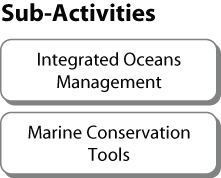 |
| Resources | 2009-2010 | 2010-2011 | 2011-2012 |
|---|---|---|---|
| $ Millions | $16.4 | $15.7 | $15.1 |
| FTEs | 117 | 118 | 118 |
| Expected Result | Canada's ocean areas managed through adoption of integrated management approaches | ||
| Estimated percentage of Canadian ocean area with integrated management structures | |||
| 31% | 31% | 31% | |
| Expected Result | Coordinated and effective oceans governance | ||
| Percentage of Large Ocean Management Areas with inter-jurisdictional Regional Implementation Committees or equivalents | |||
| 100% | 100% | 100% | |
| Percentage of Large Ocean Management Areas with Stakeholder Advisory Committees or equivalent | |||
| 100% | 100% | 100% | |
Key Priority: Health of the Oceans
The intent of the Health of the Oceans priority is to strengthen our ability to prevent, detect, and reduce pollution; increase protection for ecologically significant marine areas; enhance co-operation with provincial/territorial, Aboriginal, domestic, and international partners; and increase scientific investments in understanding the oceans. The Government of Canada will also be increasing its research and protection activities in Canada's Arctic waters.
Through its part in the Health of the Oceans initiative, Fisheries and Oceans Canada will support the establishment of a national system of Marine Protected Areas (MPAs), the designation of six new MPAs under the Oceans Act, additional science advice related to marine protection, the creation of four new virtual centres of expertise, and enhanced oil-spill response capacity in the Arctic Ocean.
Key Initiatives
DFO will support a number of initiatives related to Oceans Management, including the creation of new Oceans Centres of Expertise, the implementation of the Federal Marine Protected Area Strategy, the establishment of MPAs, and the implementation of the CCG Arctic Response Strategy.
DFO will coordinate accountability for all Health of the Oceans initiatives. This will include bi-annual performance monitoring, the development of summary annual reports, and the preparation of a final formative evaluation. DFO will track how these projects protect sensitive ocean areas, control pollution, and promote collaborative oceans management.
| 2009-2010 | 2010-2011 | 2011-2012 |
|---|---|---|
|
|
|
|
||
|
||
|
||
| Habitat Management | Program Activity |
|---|
| Description: In collaboration with others, Habitat Management involves conserving and protecting fish and fish habitat from the impacts of activities occurring in and around fresh and marine fish-bearing waters, and improving (restoring and developing) fish habitat through the administration of the habitat protection provisions of the Fisheries Act, providing advice on related provisions of the Act, and the application of non-regulatory activities. It also involves conducting environmental assessments prior to regulatory decisions listed in the Law List Regulations of the Canadian Environmental Assessment Act and participating in other environmental assessment regimes. These activities are performed in a manner consistent with the Species at Risk Act; the Policy for the Management of Fish Habitat and other operational policies; consultation with Aboriginal groups; the goals and principles of sustainable development; and the policies and priorities of the federal government. | 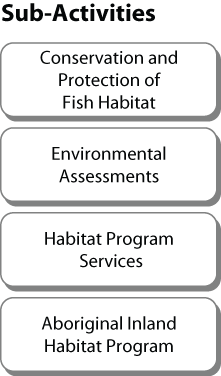 |
| Resources and Results | 2009-2010 | 2010-2011 | 2011-2012 |
|---|---|---|---|
| $ Millions | $57.7 | $54.7 | $54.5 |
| FTEs | 563 | 575 | 575 |
| Expected Result | Healthy and productive fish habitat available to sustain the production of fish species and populations that Canadians value | ||
| Percentage of Fisheries Act authorizations with compensation plans to offset the loss of fish habitat as a result of development projects | |||
| 100% | 100% | 100% | |
| Percentage of inspected works and undertakings that conform with terms and conditions of operational statements, formal advice in writing, and Fisheries Act authorizations | |||
| 100% | 100% | 100% | |
Key Initiative: Regulatory Improvement Initiative for Major Resource Projects
Budget 2007 committed to reducing the length of the federal regulatory review process for major resource projects to an average of two years. To support this commitment, DFO was allocated resources for regulatory activities under the Fisheries Act, as well as for responsibilities associated with environmental assessments and Aboriginal consultations related to major resource projects. Budget 2007 also announced the creation of a Major Projects Management Office (MPMO) within Natural Resources Canada that will oversee this initiative.
| 2009-2010 | 2010-2011 | 2011-2012 |
|---|---|---|
|
|
|
|
|
|
| Species at Risk Management | Program Activity |
|---|
| Description: Aquatic species at risk are managed to provide for the recovery of extirpated, endangered and threatened species; and the management of special concerned species to prevent them becoming at risk. This program activity involves developing recovery strategies, action plans and management plans for all aquatic species; promoting recovery implementation and monitoring of marine and anadromous (moving between fresh and salt water) species over which the federal government has exclusive jurisdiction; and promoting freshwater species for which certain provinces have specific delegated responsibilities related to fisheries management through regulations under the Fisheries Act. | 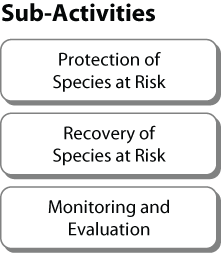 |
| Resources and Results | 2009-2010 | 2010-2011 | 2011-2012 |
|---|---|---|---|
| $ Millions | $16.9 | $17.1 | $17.7 |
| FTEs | 34 | 38 | 38 |
| Expected Result | Conservation and protection of aquatic species at risk in Canada | ||
| Percentage of recovery strategies, recovery action plans, and management plans developed within the legislated timelines, and in conformity with mandated requirements while addressing the backlog | |||
| 60% | 80% | 100% | |
Key Priorities: Supporting the Health of the Oceans
Key Initiatives
The protection, management, and recovery of species at risk are key elements of DFO's strategy to protect and preserve our aquatic resources, ecosystems, and habitats. In many cases, these species are a prominent part of Canada's natural heritage. DFO works closely with Environment Canada and the Parks Canada Agency to ensure a common framework and approach to the implementation of the Species at Risk Act (SARA). A proactive approach is taken with regard to species of special concern to prevent them from becoming at risk.
Aside from the upcoming parliamentary review of SARA, the most visible component of this horizontal activity will be the finalization of the species at risk policy suite, which will provide the policy framework for all federal activities related to the implementation of SARA.
| 2009-2010 | 2010-2011 | 2011-2012 |
|---|---|---|
|
|
|
|
|
|
|
||
| Science for Healthy and Productive Aquatic Ecosystems | Program Activity |
|---|
| Description: This program provides research, monitoring, advice, products and services and data management to ensure departmental and federal policies, programs, decisions, and regulations associated with the integrated management of Canada's oceans and fish habitat resources are informed by science advice. The science is undertaken through a network of research facilities, in collaboration with other government departments, private sector, academia and international organizations. | 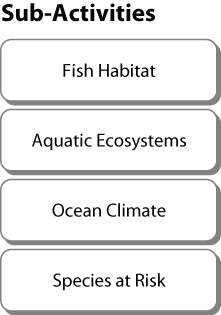 |
| Resources and Results | 2009-2010 | 2010-2011 | 2011-2012 |
|---|---|---|---|
| $ Millions | $55.4 | $54.4 | $50.0 |
| FTEs | 450 | 451 | 451 |
| Expected Result | Comprehensive understanding of aquatic ecosystem function | ||
| Number of requests for science advice on aquatic ecosystems | |||
| Complete 90% of requests for science advice on aquatic ecosystems that senior management approves | |||
| Number of Canadian Science Advisory Secretariat (CSAS) publications on aquatic ecosystems that are posted on the DFO website | |||
| Maintain 5-year average | |||
| Number of publicly available products on aquatic ecosystems completed by DFO Science | |||
| Maintain 5-year average | |||
Key Priority: Supporting the Health of the Oceans
Key Initiative: Identifying Indicators for MPAs
The Science Program will support the identification of science-based indicators for the conservation objectives of MPAs. Once indicators have been identified, monitoring protocols will be developed. These protocols will provide guidance on incorporating ecosystem indicators into monitoring programs and will facilitate appropriate quality assurance when these indicators are used.
| 2009-2010 | 2010-2011 | 2011-2012 |
|---|---|---|
|
|
|
|
||
Key Initiative: Sector Impact Advisories
The Science Program will provide scientific assessment and advice about the potential environmental impacts and ecological risks associated with specific high-priority ocean activities identified by the Oceans, Habitat and Species at Risk Program. Science will also conduct review and advisory meetings for priority oceans activities.
| 2009-2010 | 2010-2011 | 2011-2012 |
|---|---|---|
|
||
Supporting All the Department's Outcomes: Internal Services
| Internal Services4 are groups of related activities and resources that are administered to support the needs of programs and other corporate obligations of an organization. These groups are: Management and Oversight Services; Communications Services; Legal Services; Human Resources Management Services; Financial Management Services; Information Management Services; Information Technology Services; Real Property Services; Materiel Services; Acquisition Services; and Travel and Other Administrative Services. | 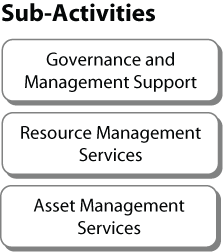 |
| Resources | 2009-2010 | 2010-2011 | 2011-2012 |
|---|---|---|---|
| $ Millions | $311.9 | $297.9 | $297.6 |
| FTEs | 1,898 | 1,942 | 1,942 |
Within Internal Services, Governance and Management Support provides the Department with the strong governance needed to allow its programs and services to provide the greatest benefits possible to Canadians with DFO's resources and assets. Communications, Legal Services, and the Executive Secretariat, in Governance and Management Support, play important roles in the Department's activities. Policy, Evaluation, and Audit all play an important role in development of programs and priorities, and in ensuing that programs are efficient and effective.
Asset Management Services works to ensure that the infrastructure that supports the Department's activities can perform as expected and is maintained and replaced in a strategic fashion.
Resource Management Services involves providing sound financial management, modern and flexible human resource management, and a comprehensive approach to information technology and management that protects vital information and makes it readily accessible for decision-making.
Treasury Board Secretariat uses a tool called the Management Accountability Framework (MAF) to provide departments with recommendations for improving their internal management. This framework, along with the analysis of key corporate risks, allows senior management to determine the Department's management priorities.
Over the coming year, organizations within the Internal Services program activity will work to address several key departmental management priorities.
4 In August 2007, Treasury Board Secretariat (TBS) promulgated The Revised Profile of the Government of Canada's Internal Services to be used by departments in their reporting documents. The services formerly called Program Enablers were renamed the Internal Services Program Activity and organized in a new structure determined by TBS. The discussion in this document follows that structure.
Key departmental management priorities:
|
Section III: Supplementary Information
Financial Highlights
| Condensed Statement of Operations | |
|---|---|
| For the Year Ended March 31 ($ millions) |
Future-oriented 2009-2010 |
| Expenses Total Expenses |
1,889.6 |
| Revenues Total Revenues |
96.1 |
| Net Cost of Operations | 1,793.5 |
| For more Information, see DFO's future-oriented financial statements. |
List of Electronic Tables
The following tables are located on the Secretariat's website:
- Details of Transfer Payment Programs (TPP) - Aboriginal Aquatic Resource and Oceans Management (AAROM)
- Details of Transfer Payment Programs (TPP)- Atlantic Integrated Commercial Fisheries Initiative
- Details of Transfer Payment Programs (TPP) - Pacific Integrated Commercial Fisheries Initiative
- Details of Transfer Payment Programs (TPP) - Aboriginal Fisheries Strategy
- Details of Transfer Payment Programs (TPP) - Aboriginal Inland Habitat Program
- Details of Transfer Payment Programs (TPP)- Aquaculture Innovation and Market Access Program (AIMAP)
- Details of Transfer Payment Programs (TPP)- DFO Small Craft Harbour Class Contribution Program
- Details of Transfer Payment Programs (TPP)- Small Craft Harbours (SCH) Divestiture Class Grant Program
- Green Procurement
- Sustainable Development Strategy (SDS)
- Horizontal Initiatives
- Upcoming Internal Audits over the next three fiscal years
- Upcoming Evaluations over the next three fiscal years
- Sources of Respendable and Non-Respendable Revenue
- Status Report on Major Crown Projects - Mid-Shore Patrol Vessels (MSPV)
- Status Report on Major Crown Projects - Offshore Fisheries Science Vessels (OFSV)
- Status Report on Major Crown Projects Offshore Oceanographic Science Vessel (OOSV)
- Status Report on Major Crown Projects - Polar Icebreaker Project
- Summary of Capital Spending by Program Activity
- User Fees